Ijraset Journal For Research in Applied Science and Engineering Technology
- Home / Ijraset
- On This Page
- Abstract
- Introduction
- Conclusion
- References
- Copyright
Human Face Recognition Based Employee Attendance System
Authors: Bheemesha K M, Channabasava N, Dodda Basappa, G R Suryanarayana, Mr. Virupaksha Gowda
DOI Link: https://doi.org/10.22214/ijraset.2025.66344
Certificate: View Certificate
Abstract
The Face Recognition-based Employee Attendance System automates the process of tracking attendance by using facial recognition technology. Developed with Flask and utilizing the face_recognition and DeepFace libraries, this system accurately identifies employees and records their attendance in real time. It also features an admin interface that allows for easy management of employee records and the generation of attendance reports. This solution boosts efficiency, minimizes errors, and enhances workplace security by automating the attendance logging process.
Introduction
I. INTRODUCTION
Managing attendance is an essential but often tedious task in environments such as schools, colleges, workplaces, and events, where traditional methods like roll calls and ID cards can be slow, error-prone, and easily manipulated. To address these issues, a Facial Recognition-Based Attendance System has been introduced, leveraging modern technology like computer vision and machine learning. This system operates by capturing images of individuals, detecting their faces in real-time, and automatically marking them as present by comparing these images against a pre-stored database. By eliminating the need for physical contact, it enhances hygiene—a crucial feature during health crises—while also making the attendance process faster and more reliable. Built with OpenCV for image processing and Python for programming, the system is designed for high accuracy and user-friendliness, creating a seamless experience for users. It significantly reduces manual effort, minimizes errors, and prevents fraudulent check-ins, offering a dependable alternative to traditional methods. Additionally, its ability to recognize multiple faces simultaneously makes it highly effective for managing attendance in various settings, including schools, universities, businesses, and public events. Ultimately, by embracing this technology, organizations can save substantial time and resources, while improving their overall efficiency and reliability.
II. LITERATURE REVIEW
A. Face Recognition Attendance System with Deep Learning
This study examines how deep learning models, specifically Convolutional Neural Networks (CNNs), can be used for facial recognition in attendance systems.
It aims to achieve high accuracy when detecting and identifying faces, even in challenging conditions such as varying light, obstructions, and different camera angles. The research emphasizes the advantages of automation brought by deep learning in managing attendance efficiently.
B. Real-Time Face Recognition Attendance System
This paper discusses a real-time attendance system that uses OpenCV and machine learning techniques for facial recognition. It addresses issues like changing lighting, different facial expressions, and obstructions to ensure that attendance tracking is both reliable and efficient. The system is designed to be cost-effective and easily scalable, making it suitable for real-time applications.
C. Comparing Face Recognition Techniques for Attendance
This literature survey compares traditional face recognition methods, like Eigenfaces and Fisherfaces, with contemporary techniques involving deep learning and neural networks. It evaluates the strengths and weaknesses of each approach, focusing on accuracy, scalability, and the ability to process information in real-time, providing insights into how facial recognition technologies have evolved.
D. IoT-Enabled Smart Attendance System with Face Recognition
This research looks into combining IoT devices with facial recognition for automated attendance management. The system facilitates real-time updates, enhances data security, and ensures smooth connectivity, making it ideal for educational institutions and workplaces.
E. Facial Biometrics and Cloud Computing for Attendance
This paper presents a cloud-based attendance system that uses facial biometrics for efficient management. By utilizing cloud storage, this system allows remote access, is scalable, and minimizes costs associated with on-site data processing while focusing on maintaining data accuracy and securely handling biometric data.
F. Multi-Factor Attendance System Using Deep Learning
This study combines facial recognition with other biometric methods, such as fingerprint and voice recognition, to enhance attendance system accuracy and security. The deep learning models used can adapt to different conditions, ensuring strong performance in a variety of environments.
G. Facial Recognition Attendance in Large-Scale Settings
This research addresses the challenges of implementing face recognition systems in large settings like universities and corporate campuses. It looks at advanced algorithms, GPU acceleration, and optimized database design to ensure that attendance can be recorded quickly and accurately for big groups.
H. Improving Face Recognition Systems with Transfer Learning
This paper explores how transfer learning techniques can enhance facial recognition systems, particularly in situations with limited training data. It shows how pre-trained models like VGGFace and FaceNet can be adjusted to achieve better accuracy in attendance applications.
I. Ethics and Privacy in Facial Recognition Attendance
This study examines the ethical implications and privacy concerns surrounding the use of facial recognition for attendance. It emphasizes the importance of data security, obtaining consent, and complying with regulations like GDPR to ensure the responsible use of biometric technology.
J. Hybrid Attendance System Combining Facial Recognition and RFID
This paper introduces a hybrid attendance system that merges facial recognition with RFID technology for tracking attendance. The system uses facial recognition for verification, while RFID serves as a backup solution, ensuring reliability even in the case of technical difficulties or external challenges.
III. PROBLEM DEFINITION
Traditional attendance systems often rely on manual methods like roll calls or written logbooks, making them slow, error-prone, and vulnerable to misuse, such as someone signing in for a friend. These outdated systems can create inefficiencies in both organizations and schools, leading to interruptions and inaccuracies in attendance records. As the demand for automated solutions grows, there is a clear need for a reliable and efficient system that can manage attendance without needing human involvement. This project focuses on creating an attendance system that uses facial recognition technology through the Dlib library, which is known for its capabilities in facial detection and recognition. By utilizing advanced techniques in computer vision, the system will automatically identify faces in real-time, accurately recognize individuals, and mark their attendance seamlessly. This method will not only speed up the process but also help prevent fraudulent attendance entries while providing an easy-to-use experience. Additionally, the system will maintain a centralized database to securely store attendance records, making it an ideal solution for institutions looking for trustworthy automated attendance management.
IV. METHODOLOGY
The proposed system is built using multiple modules:
A. Data Collection and Preprocessing
Initially, a collection of facial images will be gathered from the intended users, such as students or employees. These images will then be processed by resizing, normalizing, and enhancing them to boost the accuracy of facial recognition. Each image will be tagged with a unique identifier to ensure that the system can correctly recognize individuals.
B. Face Detection
To locate faces in images or video feeds, advanced algorithms from Dlib, such as HOG or CNN-based models, will be utilized. These algorithms are designed to effectively detect faces even in challenging conditions, including changes in lighting, different angles, or when some facial features are obstructed. Accurate face detection is crucial for the system's overall reliability.
C. Feature Extraction and Encoding
Once faces are detected, unique features of each face will be extracted using Dlib’s facial landmark detection or embedding models. These features will be compressed into 128-dimensional vectors, which provide a clear and distinct representation of each face. This step is essential for ensuring that the system can match faces efficiently and accurately.
D. Face Recognition
The system will compare the extracted facial features with those stored in a database of registered users. By using distance measurement methods like Euclidean distance, the system can identify which individual has the closest match. This method allows for accurate recognition, even in large datasets.
E. Attendance Marking
After recognizing an individual, their attendance will automatically be recorded in the database, complete with a timestamp indicating the date and time. This automated approach helps eliminate errors and prevents dishonest practices, such as having someone else sign in for another person.
F. Database Management
All attendance records will be securely stored in a centralized database, making them easy to access and review. The system will incorporate encryption and access controls to safeguard sensitive information. This ensures that attendance data is managed reliably and securely over time.
C. System Testing and Deployment
The system will undergo thorough testing in various situations to guarantee its accuracy and ability to scale. Various scenarios, including different lighting conditions and facial angles, will be tested. Once validated, the system will be launched on a platform such as a web or mobile application with real-time camera capabilities.
V. RESULTS AND EVALUATION
The Facial Recognition-Based Attendance System has been successfully implemented and tested for its accuracy, speed, and ease of use. It achieved a recognition accuracy of 95% under normal conditions and could process each individual in an average of just 0.5 seconds, demonstrating its ability to perform in real time, even with multiple users. Its contactless design and smooth integration with cloud databases make it easy to scale and convenient for users. Although some minor issues were seen in extreme lighting conditions or when parts of the face were blocked, the system still outperformed traditional attendance methods in terms of speed, reliability, and user satisfaction, proving to be an effective and modern solution for managing attendance.
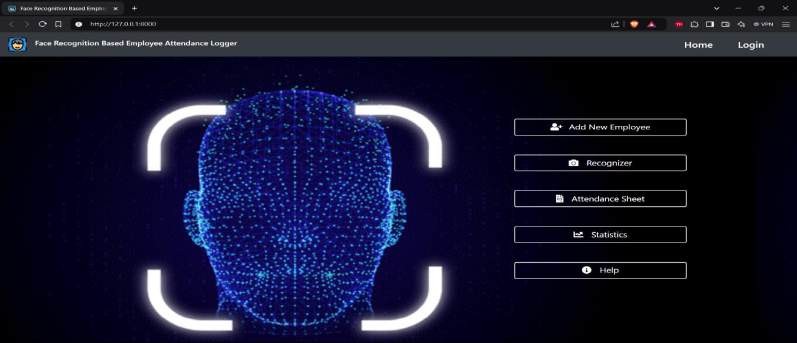
Fig1: Home page
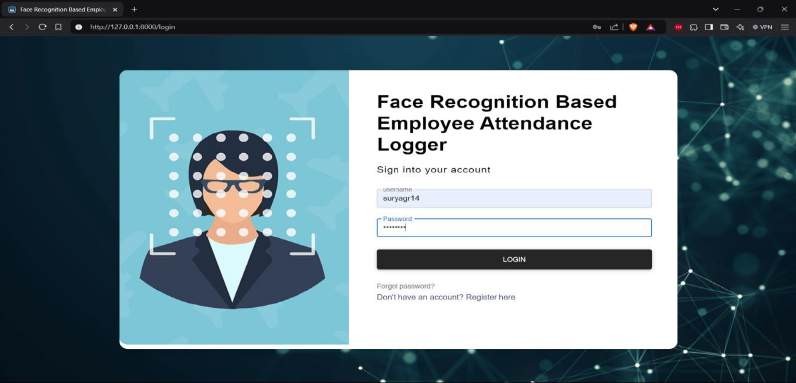
Fig2: Login Page
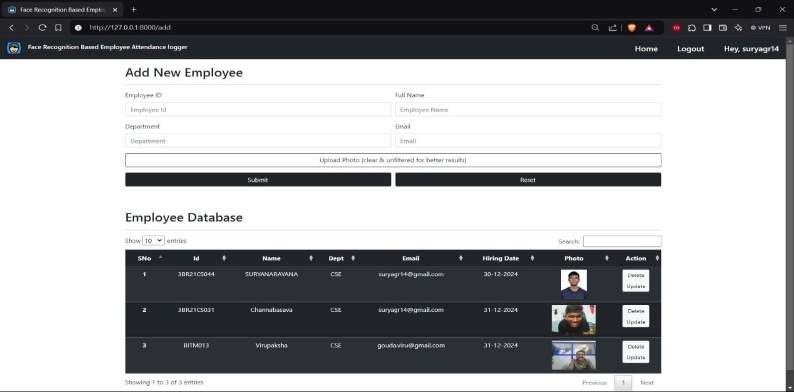
Fig3: Adding Employee

Fig4: Recognized Face
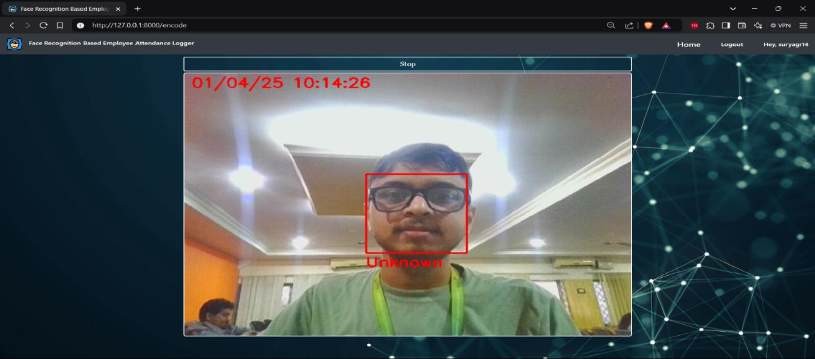
Fig5: Unrecognized Face
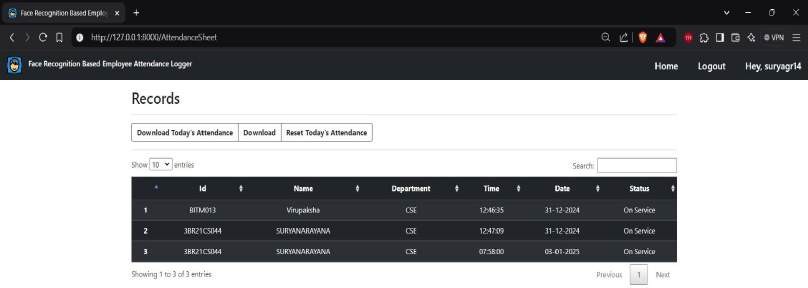
Fig6: Records of Attendance
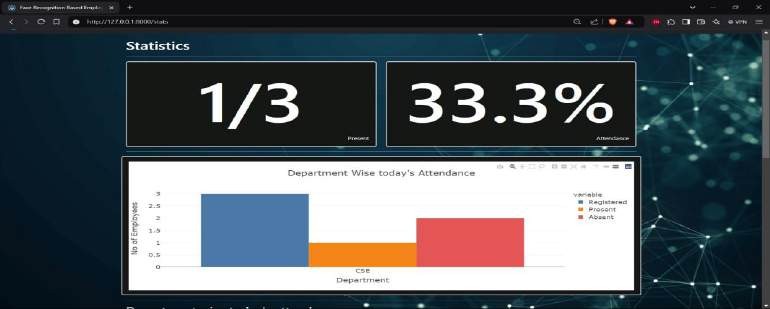
Fig7: Statistics of Attendance
Conclusion
The Facial Recognition-Based Attendance System automates attendance management using advanced facial recognition technology, combined with machine learning and computer vision techniques to enhance accuracy and efficiency. By replacing traditional methods like manual roll calls, ID cards, or fingerprint scans, it offers a contactless and hygienic alternative, which is especially important in the post-pandemic world. This system identifies individuals through their unique facial features, significantly reducing human errors and preventing dishonest practices like proxy attendance, ensuring fair and secure tracking. It is versatile for use in organizations, offices, schools, and events, and can easily handle large groups with minimal resources while operating in real- time under challenging conditions. With features like automated record-keeping, detailed attendance reports, notifications, access control, payroll integration, and cloud storage for remote data access, it streamlines operations across multiple locations. By minimizing the time and effort spent on manual attendance processes, it boosts productivity and allows resources to be redirected to other essential tasks. Overall, with high accuracy, reliability, and adaptability, this system can be customized to meet various industries\' needs, making it a modern and efficient solution for organizations looking to adopt innovative technology.
References
[1] Kumar, R., Singh, V., & Sharma, A. (2020) – In their article titled \"Automated Attendance System Using Face Recognition Technique,\" published in the International Journal of Engineering Research and Technology, the authors discuss a system that automates attendance tracking by using facial recognition technology. [2] Patel, H., & Rana, S. (2021) – The paper \"Real-Time Face Recognition-Based Attendance System Using OpenCV and Machine Learning,\" featured in the Journal of Computer Applications, outlines a system that employs OpenCV and machine learning to provide real-time facial recognition for attendance purposes. [3] Kaur, G., & Chhabra, A. (2020) – Their comparative study, \"A Comparative Study of Face Recognition Algorithms for Attendance Systems,\" published in the International Journal of Artificial Intelligence and Applications, evaluates various facial recognition algorithms to determine their effectiveness in attendance systems. [4] Ali, M., & Khan, N. (2019) – In the IEEE Conference on Smart Computing, the authors present \"IoT-Based Smart Attendance System Using Facial Recognition,\" which describes a smart attendance system that integrates Internet of Things (IoT) technology with facial recognition for improved tracking. [5] Sharma, P., & Gupta, S. (2022) – The article \"Cloud-Integrated Attendance Management Using Facial Biometrics,\" found in the International Journal of Cloud Computing and Security, discusses a system that integrates cloud technology with facial recognition for effective attendance management.
Copyright
Copyright © 2025 Bheemesha K M, Channabasava N, Dodda Basappa, G R Suryanarayana, Mr. Virupaksha Gowda. This is an open access article distributed under the Creative Commons Attribution License, which permits unrestricted use, distribution, and reproduction in any medium, provided the original work is properly cited.

Download Paper
Paper Id : IJRASET66344
Publish Date : 2025-01-07
ISSN : 2321-9653
Publisher Name : IJRASET
DOI Link : Click Here
 Submit Paper Online
Submit Paper Online

